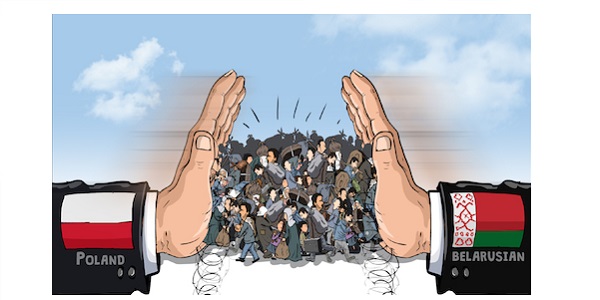A Manufactured Refugee Crisis in the EU

From Current Affairs Notes for UPSC » Editorials & In-depths » This topic
IAS EXPRESS Vs UPSC Prelims 2024: 85+ questions reflected
What is happening in the EU?
- Thousands of refugees are trying to enter Poland by crossing the Belarusian-Polish border in Eastern Europe. This has led to increased tensions in the region.
- Poland’s border constitutes the external border of the European Union.
- The EU is accusing Belarus of manufacturing the refugee crisis by allowing visa-free entry to asylum seekers and encouraging their passage into EU territory.
- Poland had resorted to the use of tear gas and water canons to repel the refugees seeking to enter its territory. Those who had breached the borders, except for the seriously ill, were pushed back.
- The refugees, including Kurds, are from the West Asian region, ravaged by war. Already, some 15 refugees have succumbed to the freezing conditions. Many are trying to reach Germany.
- Actors in this crisis:
What are the possible reasons behind the crisis?
- Belarus’ President Lukashenko denied encouraging the refugees into his country. Instead, he blamed the EU for closing its borders and causing the crisis.
- Belarus has been under sanctions since last year. It seeks to pressure the EU by creating a situation similar to the refugee crisis that occurred several years ago. In 2015, the EU gave incentives– financial and non-financial- to Turkey and Libyan warlords to get them to restrain the exodus.
- As this tactic has been blocked, Belarus proposed that Germany accept 2,000 refugees while some 7,000 more be repatriated. This too was rejected. A huge majority of the refugees are refusing to be repatriated.
- European politicians are accusing Russia of instigating the crisis in order to invade Ukraine.
- However, this accusation defied logic as to why Moscow would resort to creating a crisis for Germany and invade Ukraine, when efforts are being taken to certify the Nord Stream 2.
- The Nord Stream 2 is a pipeline project for delivering gas from Russia to the EU. It bypasses Ukraine and Belarus.
- Ukraine initially said that it didn’t see any evidence of Russian mobilization. However, it changed tack to endorse NATO’s claims of imminent Russian invasion.
- For its part, Russia is concerned about the use of drones, manufactured by Turkey, in the Donbass provinces, especially in the absence of constitutional amendment (as required under the Minsk Agreement), the absence of elections and the economic blockade in Donbass. In addition, the NATO has been undertaking provocative activities close to its borders.
How is the crisis serving the local agenda?
- In Belarus’ case, this crisis is an exercise in brinkmanship, not only with the EU, but also with Russia.
- Belarus is a Russian ally on economic and military fronts. It is also Russia’s last frontier against NATO.
- However, Belarus’ dependence on Russia doesn’t preclude it from being a difficult partner. Case in point: the Belarusian President has threatened to block the gas pipeline running between Russia and the EU.
- Poland appears as an unwilling victim of the crisis. However, the crisis is a godsend in view of the bitter dispute between Poland and the EU over the rule of law.
- Poland promotes ‘traditional values’, contrary to EU principles. This is evident from the homophobic legislation, ban on abortions and the creation of LGBT-free zone in the country. Its Constitutional Tribunal had invalidated certain provisions of the EU Treaty.
- It has banned journalists and NGOs within 3km of its frontier and is facing criticism from the Council of Europe and human rights groups.
- However, the tensions from the crisis gives the country an opportunity to increase anti-Russia rhetoric and to proclaim itself as a defender of Europe. This is despite anti-immigrant stand being a staple in its far-right politics.
- The border crisis also gives an opportunity to the EU to prove its importance to Poland by extending its support.
What is the way ahead?
- Russia has lost hope in Ukraine fulfilling its obligation under the Minsk Agreement to provide regional autonomy to Donbass.
- In 2019, the Russian President Putin allowed people from Donbass to claim Russian citizenship. In addition to this, it has been making moves to economically integrate the region.
- In this light, Ukraine’s east is slowly turning into a de facto Russian territory– similar to Crimea.
- The refugee crisis in Eastern Europe is an indication of a wider problem in the West.
- There is a need to address disparity to stem mass exodus to the West.
Conclusion:
The current border crisis in eastern Europe is a manufactured problem and the escalated rhetoric is only sub-serving the countries’ and EU’s domestic and foreign agendas at the cost of refugees.
Referred Sources
If you like this post, please share your feedback in the comments section below so that we will upload more posts like this.

